Research in Accounting Practice: Budgetary Participation Analysis
VerifiedAdded on 2021/06/18
|12
|3408
|76
Report
AI Summary
This report presents a comprehensive research plan and analysis within the field of accounting practice. It begins by outlining the objectives of the research, specifically evaluating the importance of mobile advisory services and employee participation in budgeting. The research adopts a qualitative approach to gather descriptive data from staff and employees of accounting firms, utilizing survey methods to collect primary data through a series of carefully crafted questions. The report details the selection of participants, sample size determination, and data collection techniques. It provides examples of survey questions linked to the research objectives and outlines the steps for data analysis. Furthermore, the report discusses potential limitations in applying the findings to non-accounting organizations and explores the differences between sequential explanatory and sequential exploratory designs. It also includes a literature review on employee motivation, cultural impacts on management accounting systems, and the benefits of participatory budgeting, culminating in an argument about the relationship between employee participation in budget formation and motivation, while also acknowledging factors that may demotivate employees and affect budget realization. The report concludes by emphasizing the significance of cultural factors in accounting practices.
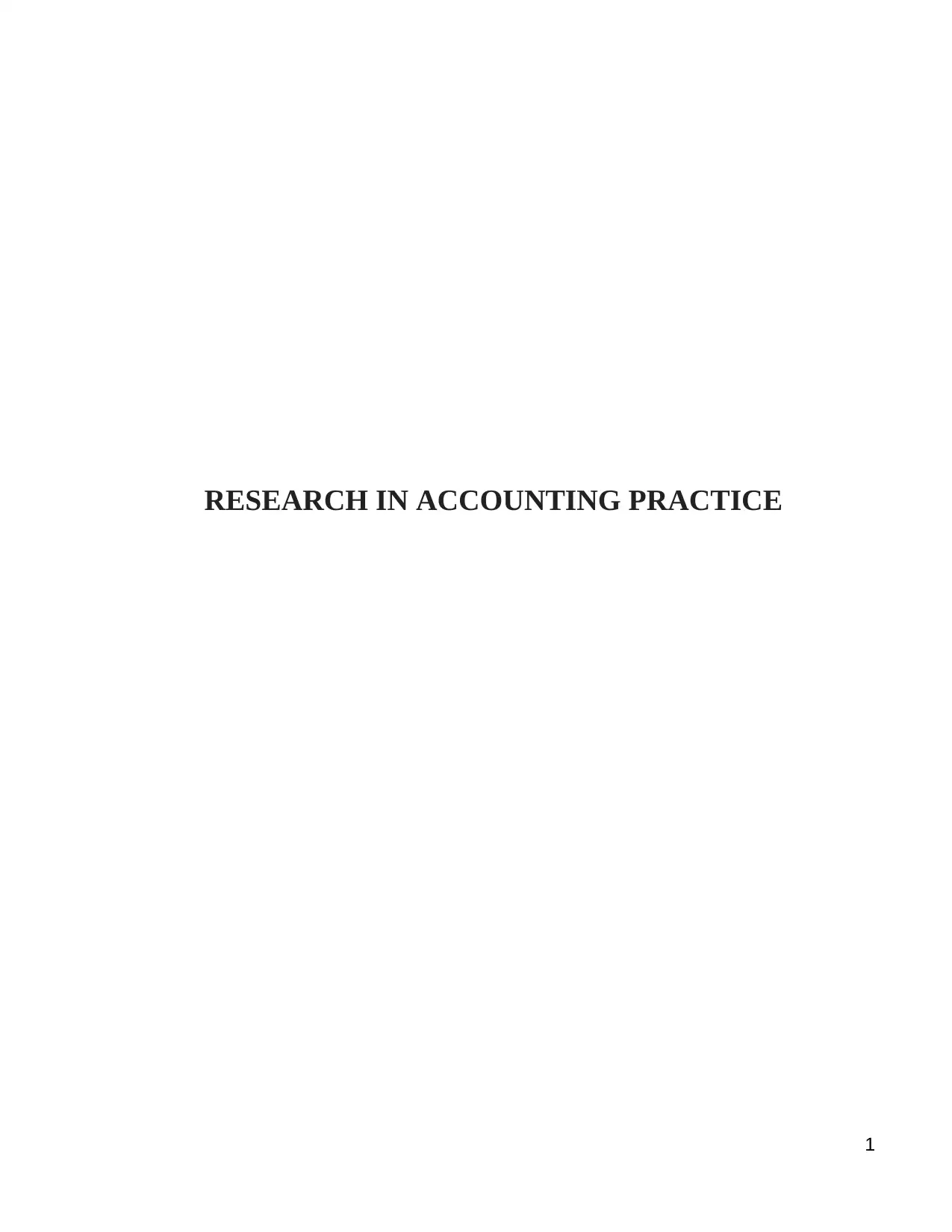
RESEARCH IN ACCOUNTING PRACTICE
1
1
Paraphrase This Document
Need a fresh take? Get an instant paraphrase of this document with our AI Paraphraser
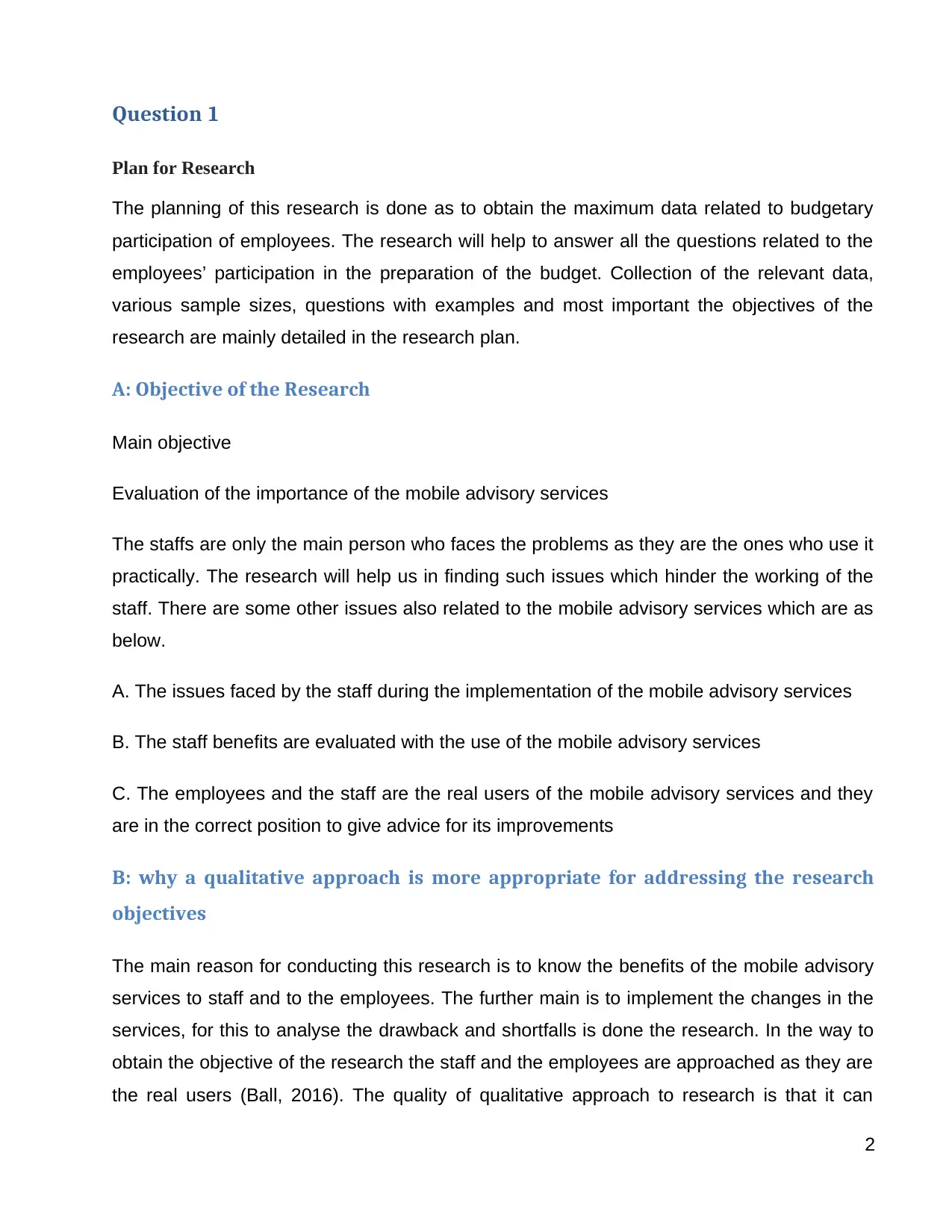
Question 1
Plan for Research
The planning of this research is done as to obtain the maximum data related to budgetary
participation of employees. The research will help to answer all the questions related to the
employees’ participation in the preparation of the budget. Collection of the relevant data,
various sample sizes, questions with examples and most important the objectives of the
research are mainly detailed in the research plan.
A: Objective of the Research
Main objective
Evaluation of the importance of the mobile advisory services
The staffs are only the main person who faces the problems as they are the ones who use it
practically. The research will help us in finding such issues which hinder the working of the
staff. There are some other issues also related to the mobile advisory services which are as
below.
A. The issues faced by the staff during the implementation of the mobile advisory services
B. The staff benefits are evaluated with the use of the mobile advisory services
C. The employees and the staff are the real users of the mobile advisory services and they
are in the correct position to give advice for its improvements
B: why a qualitative approach is more appropriate for addressing the research
objectives
The main reason for conducting this research is to know the benefits of the mobile advisory
services to staff and to the employees. The further main is to implement the changes in the
services, for this to analyse the drawback and shortfalls is done the research. In the way to
obtain the objective of the research the staff and the employees are approached as they are
the real users (Ball, 2016). The quality of qualitative approach to research is that it can
2
Plan for Research
The planning of this research is done as to obtain the maximum data related to budgetary
participation of employees. The research will help to answer all the questions related to the
employees’ participation in the preparation of the budget. Collection of the relevant data,
various sample sizes, questions with examples and most important the objectives of the
research are mainly detailed in the research plan.
A: Objective of the Research
Main objective
Evaluation of the importance of the mobile advisory services
The staffs are only the main person who faces the problems as they are the ones who use it
practically. The research will help us in finding such issues which hinder the working of the
staff. There are some other issues also related to the mobile advisory services which are as
below.
A. The issues faced by the staff during the implementation of the mobile advisory services
B. The staff benefits are evaluated with the use of the mobile advisory services
C. The employees and the staff are the real users of the mobile advisory services and they
are in the correct position to give advice for its improvements
B: why a qualitative approach is more appropriate for addressing the research
objectives
The main reason for conducting this research is to know the benefits of the mobile advisory
services to staff and to the employees. The further main is to implement the changes in the
services, for this to analyse the drawback and shortfalls is done the research. In the way to
obtain the objective of the research the staff and the employees are approached as they are
the real users (Ball, 2016). The quality of qualitative approach to research is that it can
2
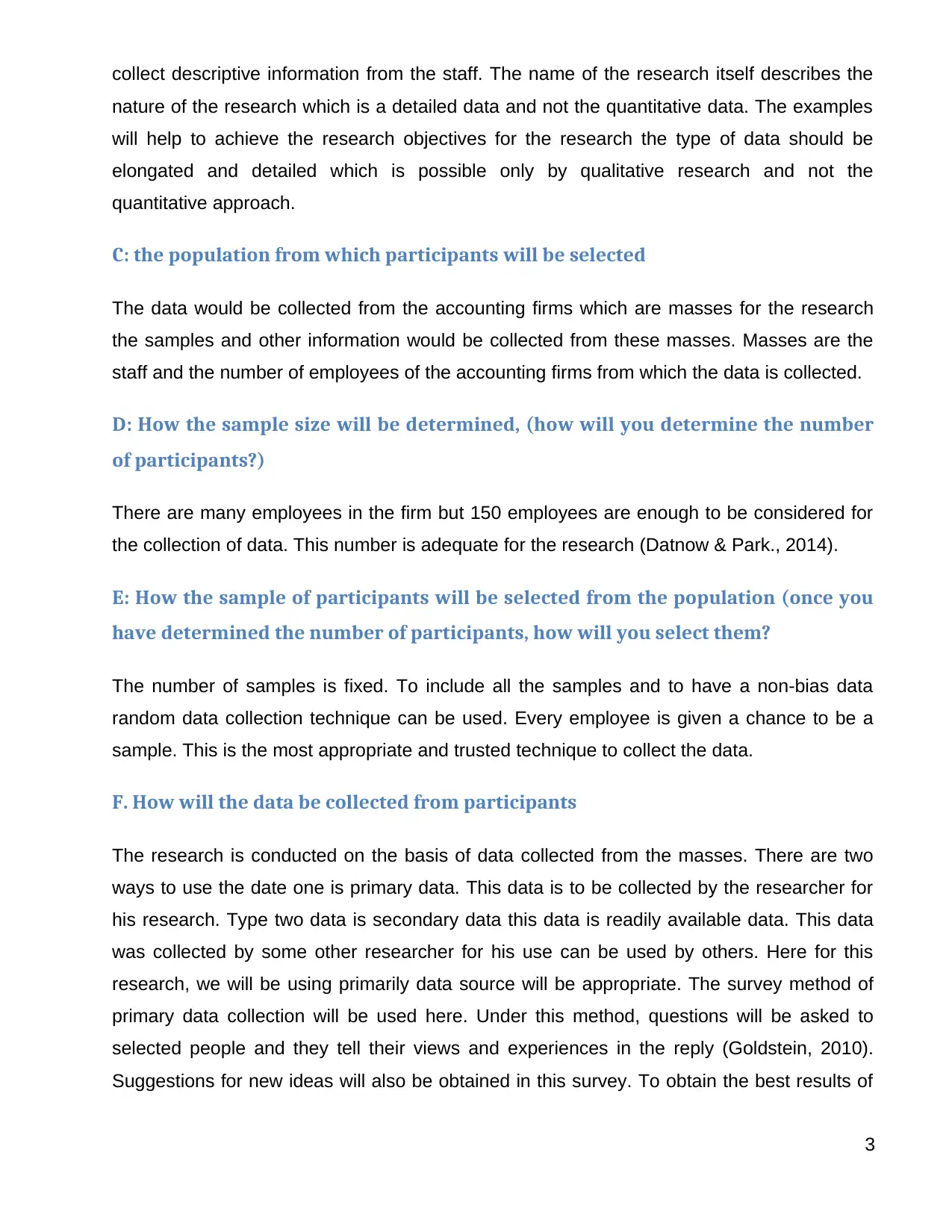
collect descriptive information from the staff. The name of the research itself describes the
nature of the research which is a detailed data and not the quantitative data. The examples
will help to achieve the research objectives for the research the type of data should be
elongated and detailed which is possible only by qualitative research and not the
quantitative approach.
C: the population from which participants will be selected
The data would be collected from the accounting firms which are masses for the research
the samples and other information would be collected from these masses. Masses are the
staff and the number of employees of the accounting firms from which the data is collected.
D: How the sample size will be determined, (how will you determine the number
of participants?)
There are many employees in the firm but 150 employees are enough to be considered for
the collection of data. This number is adequate for the research (Datnow & Park., 2014).
E: How the sample of participants will be selected from the population (once you
have determined the number of participants, how will you select them?
The number of samples is fixed. To include all the samples and to have a non-bias data
random data collection technique can be used. Every employee is given a chance to be a
sample. This is the most appropriate and trusted technique to collect the data.
F. How will the data be collected from participants
The research is conducted on the basis of data collected from the masses. There are two
ways to use the date one is primary data. This data is to be collected by the researcher for
his research. Type two data is secondary data this data is readily available data. This data
was collected by some other researcher for his use can be used by others. Here for this
research, we will be using primarily data source will be appropriate. The survey method of
primary data collection will be used here. Under this method, questions will be asked to
selected people and they tell their views and experiences in the reply (Goldstein, 2010).
Suggestions for new ideas will also be obtained in this survey. To obtain the best results of
3
nature of the research which is a detailed data and not the quantitative data. The examples
will help to achieve the research objectives for the research the type of data should be
elongated and detailed which is possible only by qualitative research and not the
quantitative approach.
C: the population from which participants will be selected
The data would be collected from the accounting firms which are masses for the research
the samples and other information would be collected from these masses. Masses are the
staff and the number of employees of the accounting firms from which the data is collected.
D: How the sample size will be determined, (how will you determine the number
of participants?)
There are many employees in the firm but 150 employees are enough to be considered for
the collection of data. This number is adequate for the research (Datnow & Park., 2014).
E: How the sample of participants will be selected from the population (once you
have determined the number of participants, how will you select them?
The number of samples is fixed. To include all the samples and to have a non-bias data
random data collection technique can be used. Every employee is given a chance to be a
sample. This is the most appropriate and trusted technique to collect the data.
F. How will the data be collected from participants
The research is conducted on the basis of data collected from the masses. There are two
ways to use the date one is primary data. This data is to be collected by the researcher for
his research. Type two data is secondary data this data is readily available data. This data
was collected by some other researcher for his use can be used by others. Here for this
research, we will be using primarily data source will be appropriate. The survey method of
primary data collection will be used here. Under this method, questions will be asked to
selected people and they tell their views and experiences in the reply (Goldstein, 2010).
Suggestions for new ideas will also be obtained in this survey. To obtain the best results of
3
⊘ This is a preview!⊘
Do you want full access?
Subscribe today to unlock all pages.

Trusted by 1+ million students worldwide
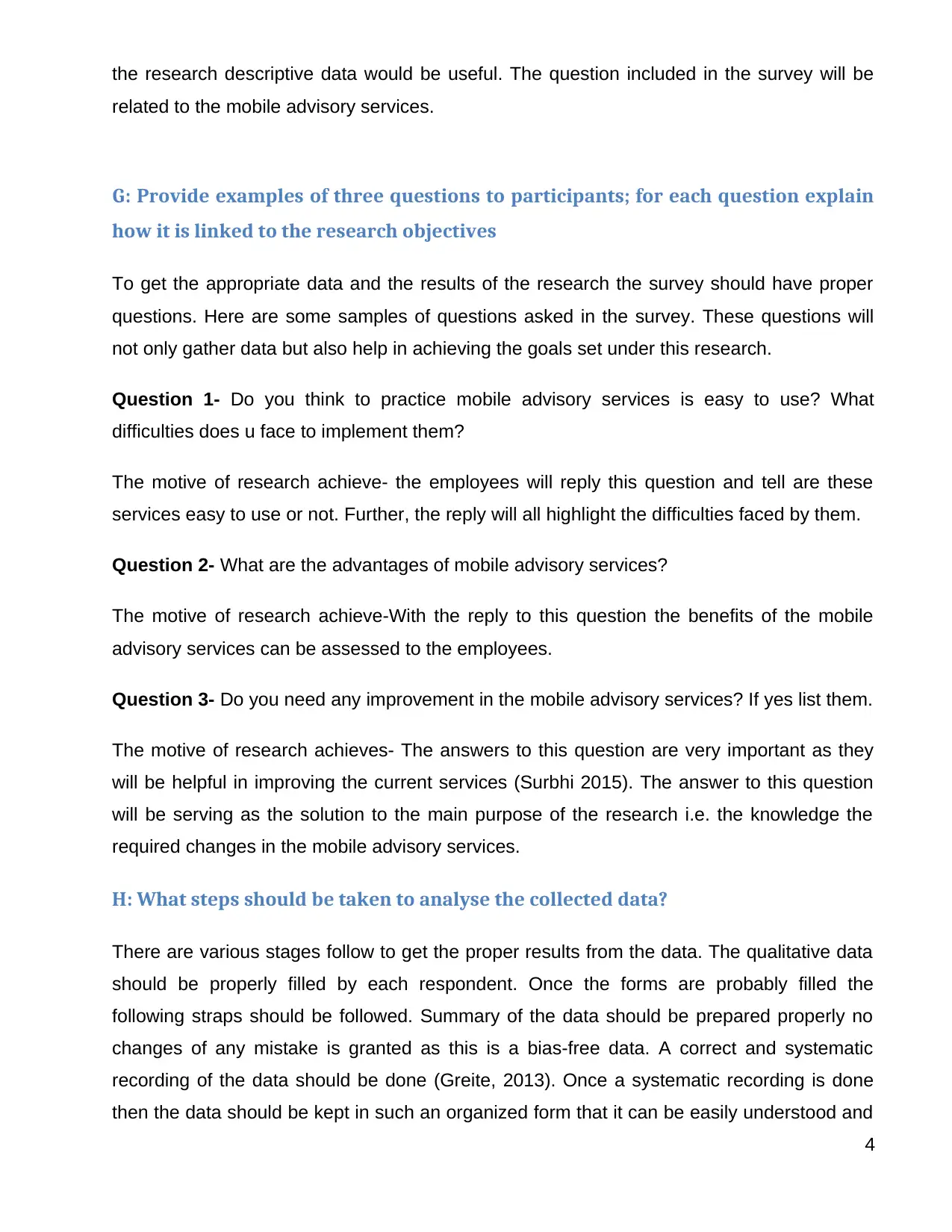
the research descriptive data would be useful. The question included in the survey will be
related to the mobile advisory services.
G: Provide examples of three questions to participants; for each question explain
how it is linked to the research objectives
To get the appropriate data and the results of the research the survey should have proper
questions. Here are some samples of questions asked in the survey. These questions will
not only gather data but also help in achieving the goals set under this research.
Question 1- Do you think to practice mobile advisory services is easy to use? What
difficulties does u face to implement them?
The motive of research achieve- the employees will reply this question and tell are these
services easy to use or not. Further, the reply will all highlight the difficulties faced by them.
Question 2- What are the advantages of mobile advisory services?
The motive of research achieve-With the reply to this question the benefits of the mobile
advisory services can be assessed to the employees.
Question 3- Do you need any improvement in the mobile advisory services? If yes list them.
The motive of research achieves- The answers to this question are very important as they
will be helpful in improving the current services (Surbhi 2015). The answer to this question
will be serving as the solution to the main purpose of the research i.e. the knowledge the
required changes in the mobile advisory services.
H: What steps should be taken to analyse the collected data?
There are various stages follow to get the proper results from the data. The qualitative data
should be properly filled by each respondent. Once the forms are probably filled the
following straps should be followed. Summary of the data should be prepared properly no
changes of any mistake is granted as this is a bias-free data. A correct and systematic
recording of the data should be done (Greite, 2013). Once a systematic recording is done
then the data should be kept in such an organized form that it can be easily understood and
4
related to the mobile advisory services.
G: Provide examples of three questions to participants; for each question explain
how it is linked to the research objectives
To get the appropriate data and the results of the research the survey should have proper
questions. Here are some samples of questions asked in the survey. These questions will
not only gather data but also help in achieving the goals set under this research.
Question 1- Do you think to practice mobile advisory services is easy to use? What
difficulties does u face to implement them?
The motive of research achieve- the employees will reply this question and tell are these
services easy to use or not. Further, the reply will all highlight the difficulties faced by them.
Question 2- What are the advantages of mobile advisory services?
The motive of research achieve-With the reply to this question the benefits of the mobile
advisory services can be assessed to the employees.
Question 3- Do you need any improvement in the mobile advisory services? If yes list them.
The motive of research achieves- The answers to this question are very important as they
will be helpful in improving the current services (Surbhi 2015). The answer to this question
will be serving as the solution to the main purpose of the research i.e. the knowledge the
required changes in the mobile advisory services.
H: What steps should be taken to analyse the collected data?
There are various stages follow to get the proper results from the data. The qualitative data
should be properly filled by each respondent. Once the forms are probably filled the
following straps should be followed. Summary of the data should be prepared properly no
changes of any mistake is granted as this is a bias-free data. A correct and systematic
recording of the data should be done (Greite, 2013). Once a systematic recording is done
then the data should be kept in such an organized form that it can be easily understood and
4
Paraphrase This Document
Need a fresh take? Get an instant paraphrase of this document with our AI Paraphraser
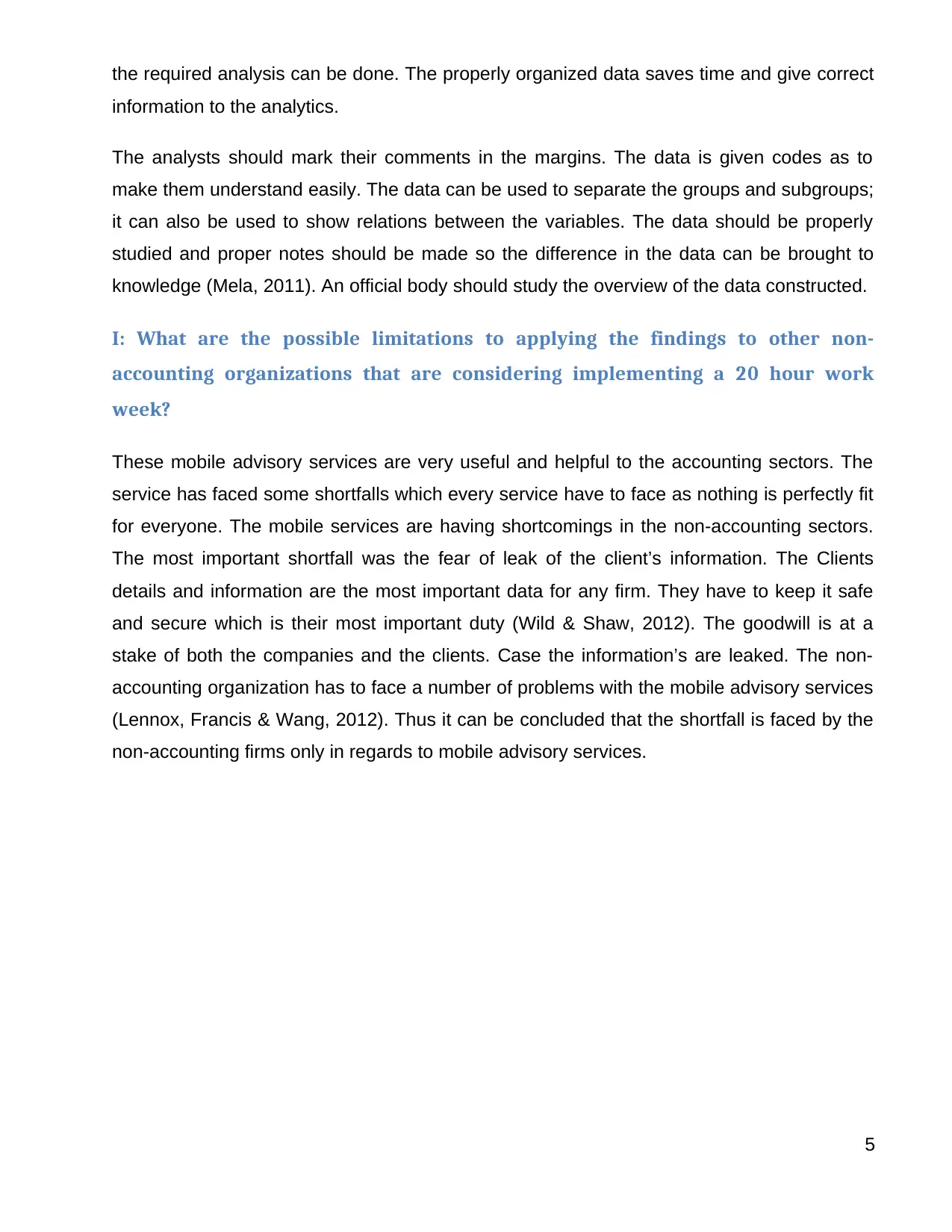
the required analysis can be done. The properly organized data saves time and give correct
information to the analytics.
The analysts should mark their comments in the margins. The data is given codes as to
make them understand easily. The data can be used to separate the groups and subgroups;
it can also be used to show relations between the variables. The data should be properly
studied and proper notes should be made so the difference in the data can be brought to
knowledge (Mela, 2011). An official body should study the overview of the data constructed.
I: What are the possible limitations to applying the findings to other non-
accounting organizations that are considering implementing a 20 hour work
week?
These mobile advisory services are very useful and helpful to the accounting sectors. The
service has faced some shortfalls which every service have to face as nothing is perfectly fit
for everyone. The mobile services are having shortcomings in the non-accounting sectors.
The most important shortfall was the fear of leak of the client’s information. The Clients
details and information are the most important data for any firm. They have to keep it safe
and secure which is their most important duty (Wild & Shaw, 2012). The goodwill is at a
stake of both the companies and the clients. Case the information’s are leaked. The non-
accounting organization has to face a number of problems with the mobile advisory services
(Lennox, Francis & Wang, 2012). Thus it can be concluded that the shortfall is faced by the
non-accounting firms only in regards to mobile advisory services.
5
information to the analytics.
The analysts should mark their comments in the margins. The data is given codes as to
make them understand easily. The data can be used to separate the groups and subgroups;
it can also be used to show relations between the variables. The data should be properly
studied and proper notes should be made so the difference in the data can be brought to
knowledge (Mela, 2011). An official body should study the overview of the data constructed.
I: What are the possible limitations to applying the findings to other non-
accounting organizations that are considering implementing a 20 hour work
week?
These mobile advisory services are very useful and helpful to the accounting sectors. The
service has faced some shortfalls which every service have to face as nothing is perfectly fit
for everyone. The mobile services are having shortcomings in the non-accounting sectors.
The most important shortfall was the fear of leak of the client’s information. The Clients
details and information are the most important data for any firm. They have to keep it safe
and secure which is their most important duty (Wild & Shaw, 2012). The goodwill is at a
stake of both the companies and the clients. Case the information’s are leaked. The non-
accounting organization has to face a number of problems with the mobile advisory services
(Lennox, Francis & Wang, 2012). Thus it can be concluded that the shortfall is faced by the
non-accounting firms only in regards to mobile advisory services.
5
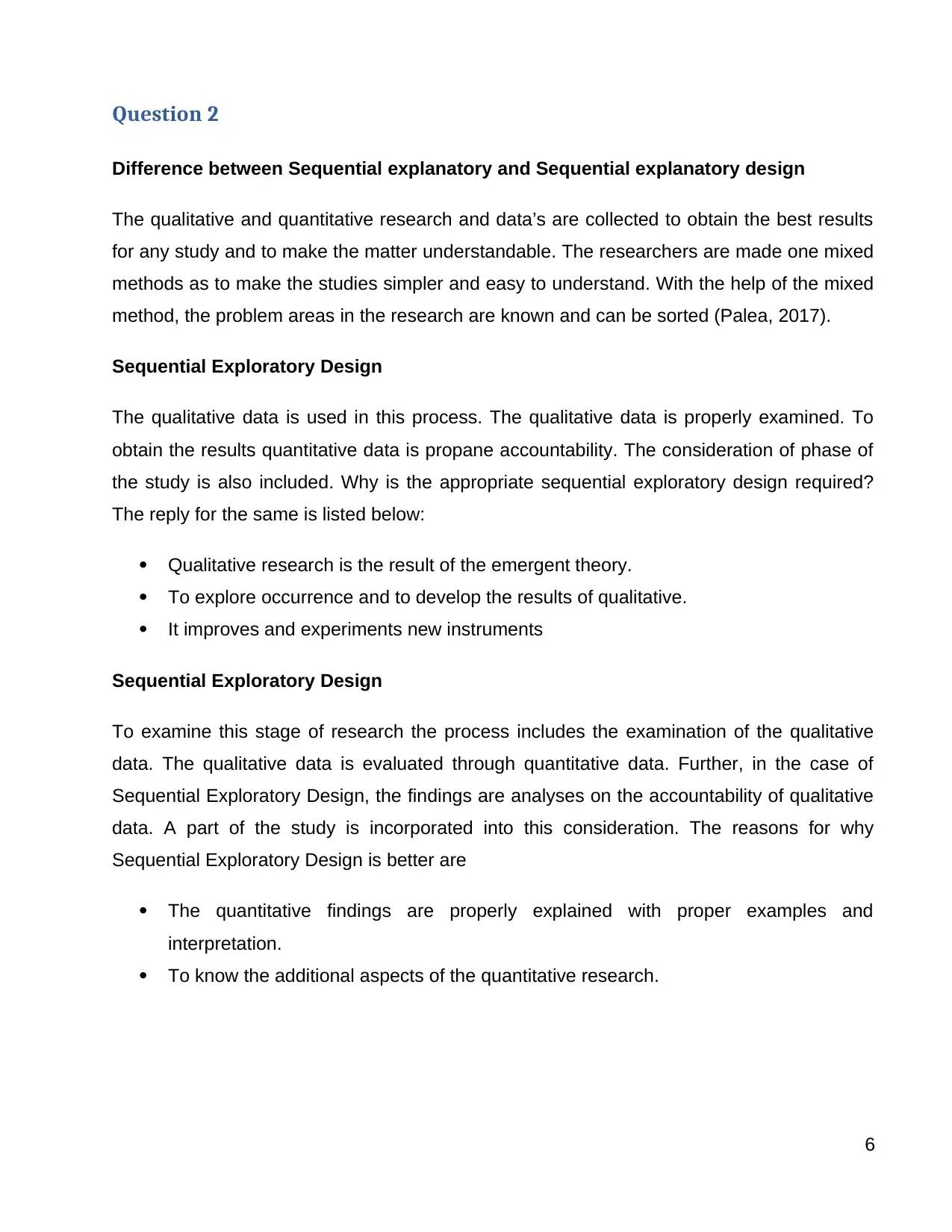
Question 2
Difference between Sequential explanatory and Sequential explanatory design
The qualitative and quantitative research and data’s are collected to obtain the best results
for any study and to make the matter understandable. The researchers are made one mixed
methods as to make the studies simpler and easy to understand. With the help of the mixed
method, the problem areas in the research are known and can be sorted (Palea, 2017).
Sequential Exploratory Design
The qualitative data is used in this process. The qualitative data is properly examined. To
obtain the results quantitative data is propane accountability. The consideration of phase of
the study is also included. Why is the appropriate sequential exploratory design required?
The reply for the same is listed below:
Qualitative research is the result of the emergent theory.
To explore occurrence and to develop the results of qualitative.
It improves and experiments new instruments
Sequential Exploratory Design
To examine this stage of research the process includes the examination of the qualitative
data. The qualitative data is evaluated through quantitative data. Further, in the case of
Sequential Exploratory Design, the findings are analyses on the accountability of qualitative
data. A part of the study is incorporated into this consideration. The reasons for why
Sequential Exploratory Design is better are
The quantitative findings are properly explained with proper examples and
interpretation.
To know the additional aspects of the quantitative research.
6
Difference between Sequential explanatory and Sequential explanatory design
The qualitative and quantitative research and data’s are collected to obtain the best results
for any study and to make the matter understandable. The researchers are made one mixed
methods as to make the studies simpler and easy to understand. With the help of the mixed
method, the problem areas in the research are known and can be sorted (Palea, 2017).
Sequential Exploratory Design
The qualitative data is used in this process. The qualitative data is properly examined. To
obtain the results quantitative data is propane accountability. The consideration of phase of
the study is also included. Why is the appropriate sequential exploratory design required?
The reply for the same is listed below:
Qualitative research is the result of the emergent theory.
To explore occurrence and to develop the results of qualitative.
It improves and experiments new instruments
Sequential Exploratory Design
To examine this stage of research the process includes the examination of the qualitative
data. The qualitative data is evaluated through quantitative data. Further, in the case of
Sequential Exploratory Design, the findings are analyses on the accountability of qualitative
data. A part of the study is incorporated into this consideration. The reasons for why
Sequential Exploratory Design is better are
The quantitative findings are properly explained with proper examples and
interpretation.
To know the additional aspects of the quantitative research.
6
⊘ This is a preview!⊘
Do you want full access?
Subscribe today to unlock all pages.

Trusted by 1+ million students worldwide
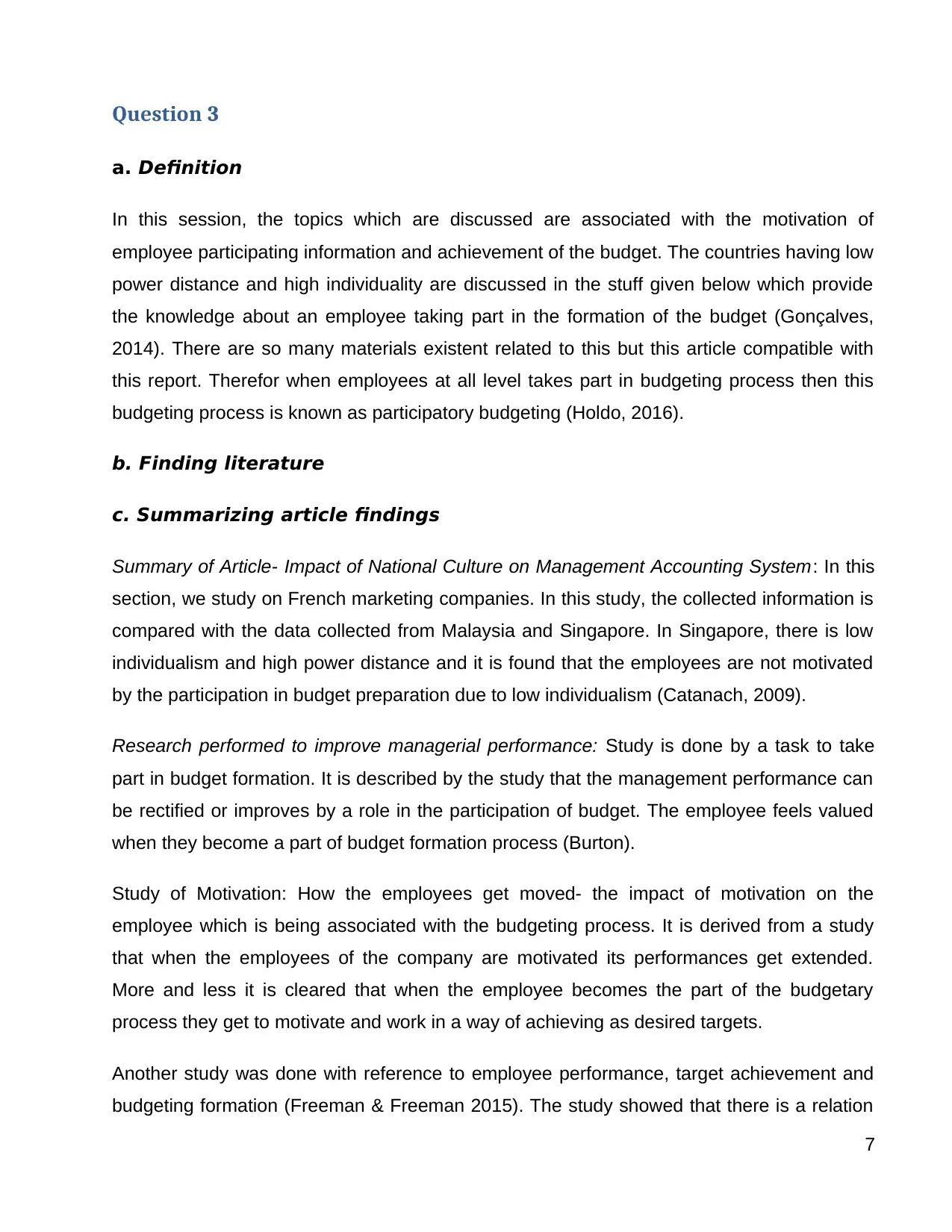
Question 3
a. Definition
In this session, the topics which are discussed are associated with the motivation of
employee participating information and achievement of the budget. The countries having low
power distance and high individuality are discussed in the stuff given below which provide
the knowledge about an employee taking part in the formation of the budget (Gonçalves,
2014). There are so many materials existent related to this but this article compatible with
this report. Therefor when employees at all level takes part in budgeting process then this
budgeting process is known as participatory budgeting (Holdo, 2016).
b. Finding literature
c. Summarizing article findings
Summary of Article- Impact of National Culture on Management Accounting System: In this
section, we study on French marketing companies. In this study, the collected information is
compared with the data collected from Malaysia and Singapore. In Singapore, there is low
individualism and high power distance and it is found that the employees are not motivated
by the participation in budget preparation due to low individualism (Catanach, 2009).
Research performed to improve managerial performance: Study is done by a task to take
part in budget formation. It is described by the study that the management performance can
be rectified or improves by a role in the participation of budget. The employee feels valued
when they become a part of budget formation process (Burton).
Study of Motivation: How the employees get moved- the impact of motivation on the
employee which is being associated with the budgeting process. It is derived from a study
that when the employees of the company are motivated its performances get extended.
More and less it is cleared that when the employee becomes the part of the budgetary
process they get to motivate and work in a way of achieving as desired targets.
Another study was done with reference to employee performance, target achievement and
budgeting formation (Freeman & Freeman 2015). The study showed that there is a relation
7
a. Definition
In this session, the topics which are discussed are associated with the motivation of
employee participating information and achievement of the budget. The countries having low
power distance and high individuality are discussed in the stuff given below which provide
the knowledge about an employee taking part in the formation of the budget (Gonçalves,
2014). There are so many materials existent related to this but this article compatible with
this report. Therefor when employees at all level takes part in budgeting process then this
budgeting process is known as participatory budgeting (Holdo, 2016).
b. Finding literature
c. Summarizing article findings
Summary of Article- Impact of National Culture on Management Accounting System: In this
section, we study on French marketing companies. In this study, the collected information is
compared with the data collected from Malaysia and Singapore. In Singapore, there is low
individualism and high power distance and it is found that the employees are not motivated
by the participation in budget preparation due to low individualism (Catanach, 2009).
Research performed to improve managerial performance: Study is done by a task to take
part in budget formation. It is described by the study that the management performance can
be rectified or improves by a role in the participation of budget. The employee feels valued
when they become a part of budget formation process (Burton).
Study of Motivation: How the employees get moved- the impact of motivation on the
employee which is being associated with the budgeting process. It is derived from a study
that when the employees of the company are motivated its performances get extended.
More and less it is cleared that when the employee becomes the part of the budgetary
process they get to motivate and work in a way of achieving as desired targets.
Another study was done with reference to employee performance, target achievement and
budgeting formation (Freeman & Freeman 2015). The study showed that there is a relation
7
Paraphrase This Document
Need a fresh take? Get an instant paraphrase of this document with our AI Paraphraser
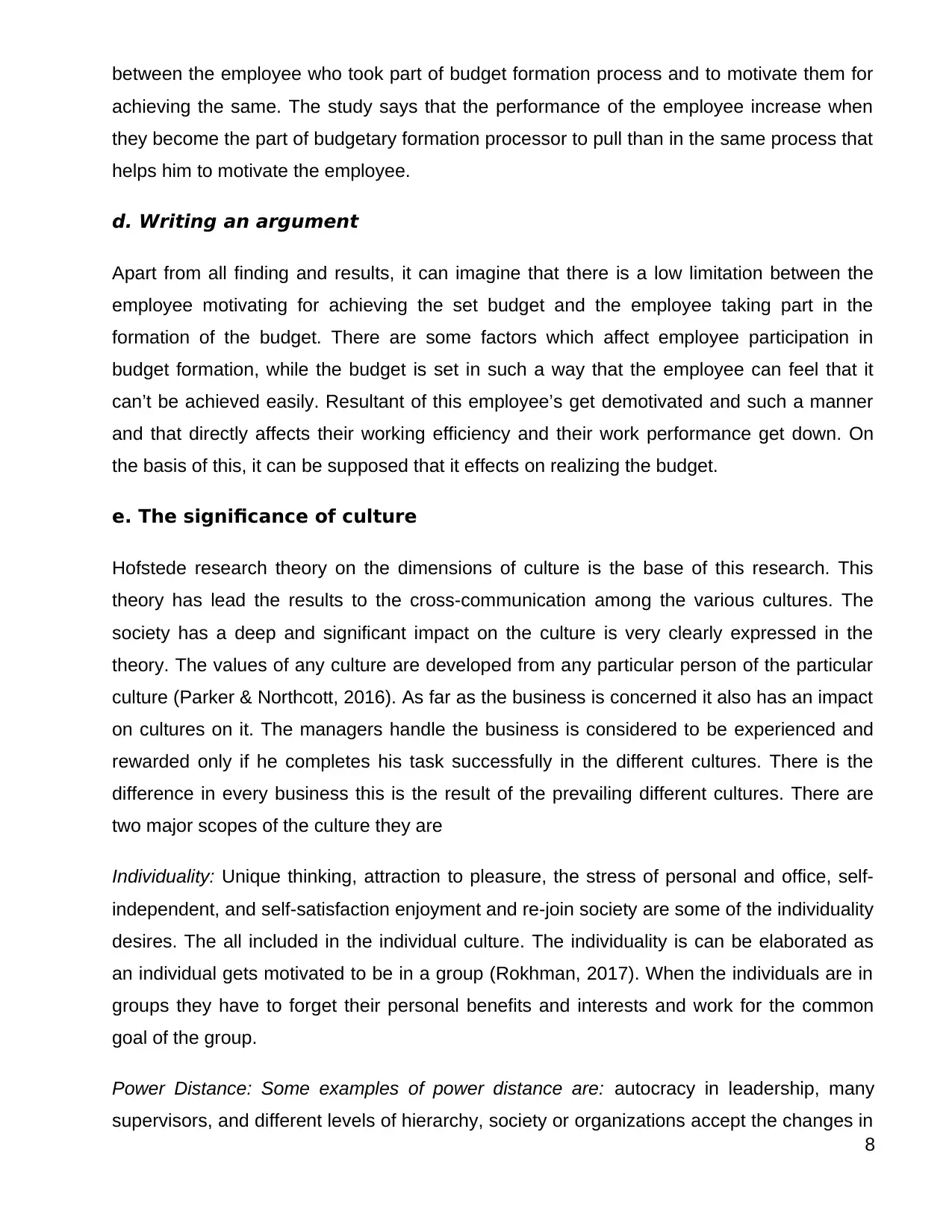
between the employee who took part of budget formation process and to motivate them for
achieving the same. The study says that the performance of the employee increase when
they become the part of budgetary formation processor to pull than in the same process that
helps him to motivate the employee.
d. Writing an argument
Apart from all finding and results, it can imagine that there is a low limitation between the
employee motivating for achieving the set budget and the employee taking part in the
formation of the budget. There are some factors which affect employee participation in
budget formation, while the budget is set in such a way that the employee can feel that it
can’t be achieved easily. Resultant of this employee’s get demotivated and such a manner
and that directly affects their working efficiency and their work performance get down. On
the basis of this, it can be supposed that it effects on realizing the budget.
e. The significance of culture
Hofstede research theory on the dimensions of culture is the base of this research. This
theory has lead the results to the cross-communication among the various cultures. The
society has a deep and significant impact on the culture is very clearly expressed in the
theory. The values of any culture are developed from any particular person of the particular
culture (Parker & Northcott, 2016). As far as the business is concerned it also has an impact
on cultures on it. The managers handle the business is considered to be experienced and
rewarded only if he completes his task successfully in the different cultures. There is the
difference in every business this is the result of the prevailing different cultures. There are
two major scopes of the culture they are
Individuality: Unique thinking, attraction to pleasure, the stress of personal and office, self-
independent, and self-satisfaction enjoyment and re-join society are some of the individuality
desires. The all included in the individual culture. The individuality is can be elaborated as
an individual gets motivated to be in a group (Rokhman, 2017). When the individuals are in
groups they have to forget their personal benefits and interests and work for the common
goal of the group.
Power Distance: Some examples of power distance are: autocracy in leadership, many
supervisors, and different levels of hierarchy, society or organizations accept the changes in
8
achieving the same. The study says that the performance of the employee increase when
they become the part of budgetary formation processor to pull than in the same process that
helps him to motivate the employee.
d. Writing an argument
Apart from all finding and results, it can imagine that there is a low limitation between the
employee motivating for achieving the set budget and the employee taking part in the
formation of the budget. There are some factors which affect employee participation in
budget formation, while the budget is set in such a way that the employee can feel that it
can’t be achieved easily. Resultant of this employee’s get demotivated and such a manner
and that directly affects their working efficiency and their work performance get down. On
the basis of this, it can be supposed that it effects on realizing the budget.
e. The significance of culture
Hofstede research theory on the dimensions of culture is the base of this research. This
theory has lead the results to the cross-communication among the various cultures. The
society has a deep and significant impact on the culture is very clearly expressed in the
theory. The values of any culture are developed from any particular person of the particular
culture (Parker & Northcott, 2016). As far as the business is concerned it also has an impact
on cultures on it. The managers handle the business is considered to be experienced and
rewarded only if he completes his task successfully in the different cultures. There is the
difference in every business this is the result of the prevailing different cultures. There are
two major scopes of the culture they are
Individuality: Unique thinking, attraction to pleasure, the stress of personal and office, self-
independent, and self-satisfaction enjoyment and re-join society are some of the individuality
desires. The all included in the individual culture. The individuality is can be elaborated as
an individual gets motivated to be in a group (Rokhman, 2017). When the individuals are in
groups they have to forget their personal benefits and interests and work for the common
goal of the group.
Power Distance: Some examples of power distance are: autocracy in leadership, many
supervisors, and different levels of hierarchy, society or organizations accept the changes in
8
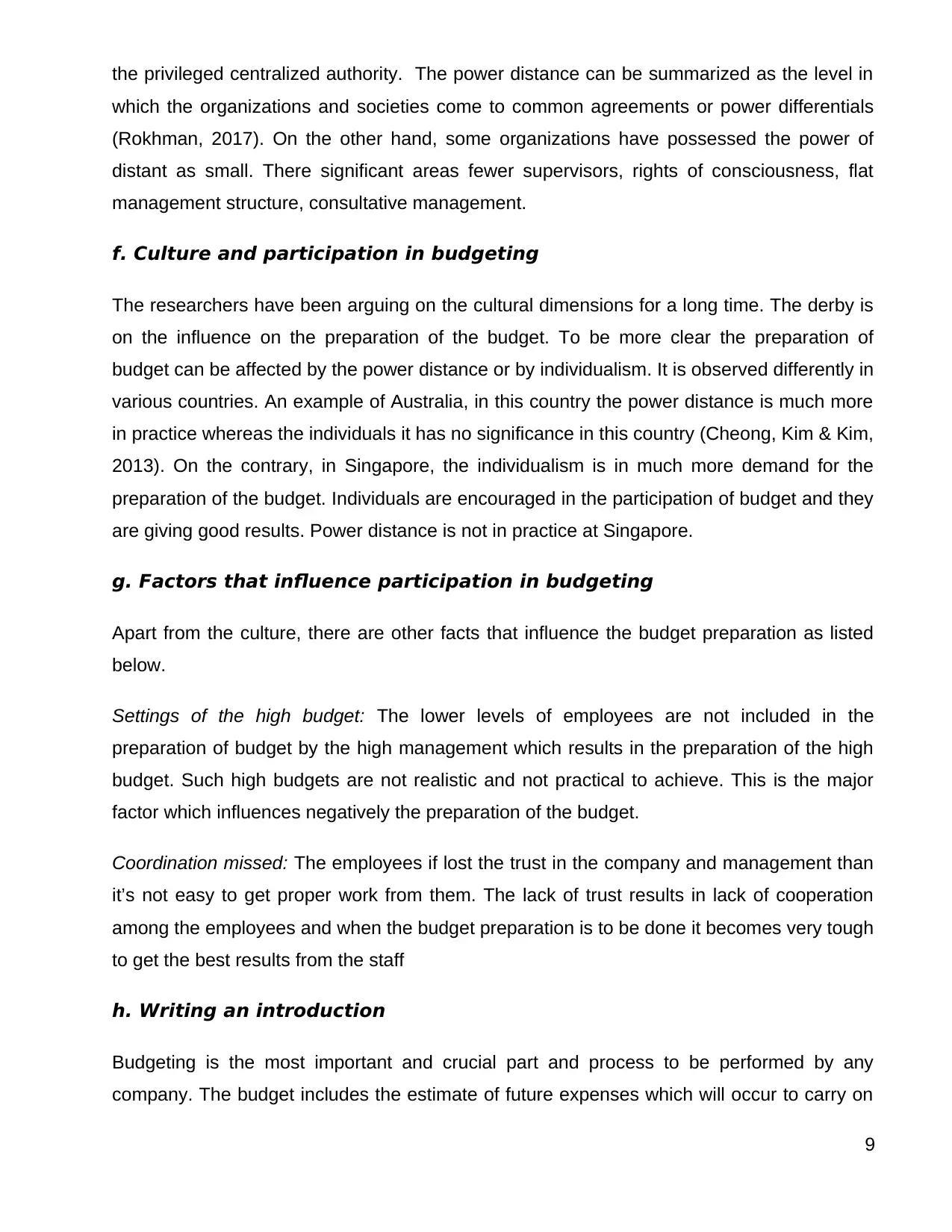
the privileged centralized authority. The power distance can be summarized as the level in
which the organizations and societies come to common agreements or power differentials
(Rokhman, 2017). On the other hand, some organizations have possessed the power of
distant as small. There significant areas fewer supervisors, rights of consciousness, flat
management structure, consultative management.
f. Culture and participation in budgeting
The researchers have been arguing on the cultural dimensions for a long time. The derby is
on the influence on the preparation of the budget. To be more clear the preparation of
budget can be affected by the power distance or by individualism. It is observed differently in
various countries. An example of Australia, in this country the power distance is much more
in practice whereas the individuals it has no significance in this country (Cheong, Kim & Kim,
2013). On the contrary, in Singapore, the individualism is in much more demand for the
preparation of the budget. Individuals are encouraged in the participation of budget and they
are giving good results. Power distance is not in practice at Singapore.
g. Factors that influence participation in budgeting
Apart from the culture, there are other facts that influence the budget preparation as listed
below.
Settings of the high budget: The lower levels of employees are not included in the
preparation of budget by the high management which results in the preparation of the high
budget. Such high budgets are not realistic and not practical to achieve. This is the major
factor which influences negatively the preparation of the budget.
Coordination missed: The employees if lost the trust in the company and management than
it’s not easy to get proper work from them. The lack of trust results in lack of cooperation
among the employees and when the budget preparation is to be done it becomes very tough
to get the best results from the staff
h. Writing an introduction
Budgeting is the most important and crucial part and process to be performed by any
company. The budget includes the estimate of future expenses which will occur to carry on
9
which the organizations and societies come to common agreements or power differentials
(Rokhman, 2017). On the other hand, some organizations have possessed the power of
distant as small. There significant areas fewer supervisors, rights of consciousness, flat
management structure, consultative management.
f. Culture and participation in budgeting
The researchers have been arguing on the cultural dimensions for a long time. The derby is
on the influence on the preparation of the budget. To be more clear the preparation of
budget can be affected by the power distance or by individualism. It is observed differently in
various countries. An example of Australia, in this country the power distance is much more
in practice whereas the individuals it has no significance in this country (Cheong, Kim & Kim,
2013). On the contrary, in Singapore, the individualism is in much more demand for the
preparation of the budget. Individuals are encouraged in the participation of budget and they
are giving good results. Power distance is not in practice at Singapore.
g. Factors that influence participation in budgeting
Apart from the culture, there are other facts that influence the budget preparation as listed
below.
Settings of the high budget: The lower levels of employees are not included in the
preparation of budget by the high management which results in the preparation of the high
budget. Such high budgets are not realistic and not practical to achieve. This is the major
factor which influences negatively the preparation of the budget.
Coordination missed: The employees if lost the trust in the company and management than
it’s not easy to get proper work from them. The lack of trust results in lack of cooperation
among the employees and when the budget preparation is to be done it becomes very tough
to get the best results from the staff
h. Writing an introduction
Budgeting is the most important and crucial part and process to be performed by any
company. The budget includes the estimate of future expenses which will occur to carry on
9
⊘ This is a preview!⊘
Do you want full access?
Subscribe today to unlock all pages.

Trusted by 1+ million students worldwide
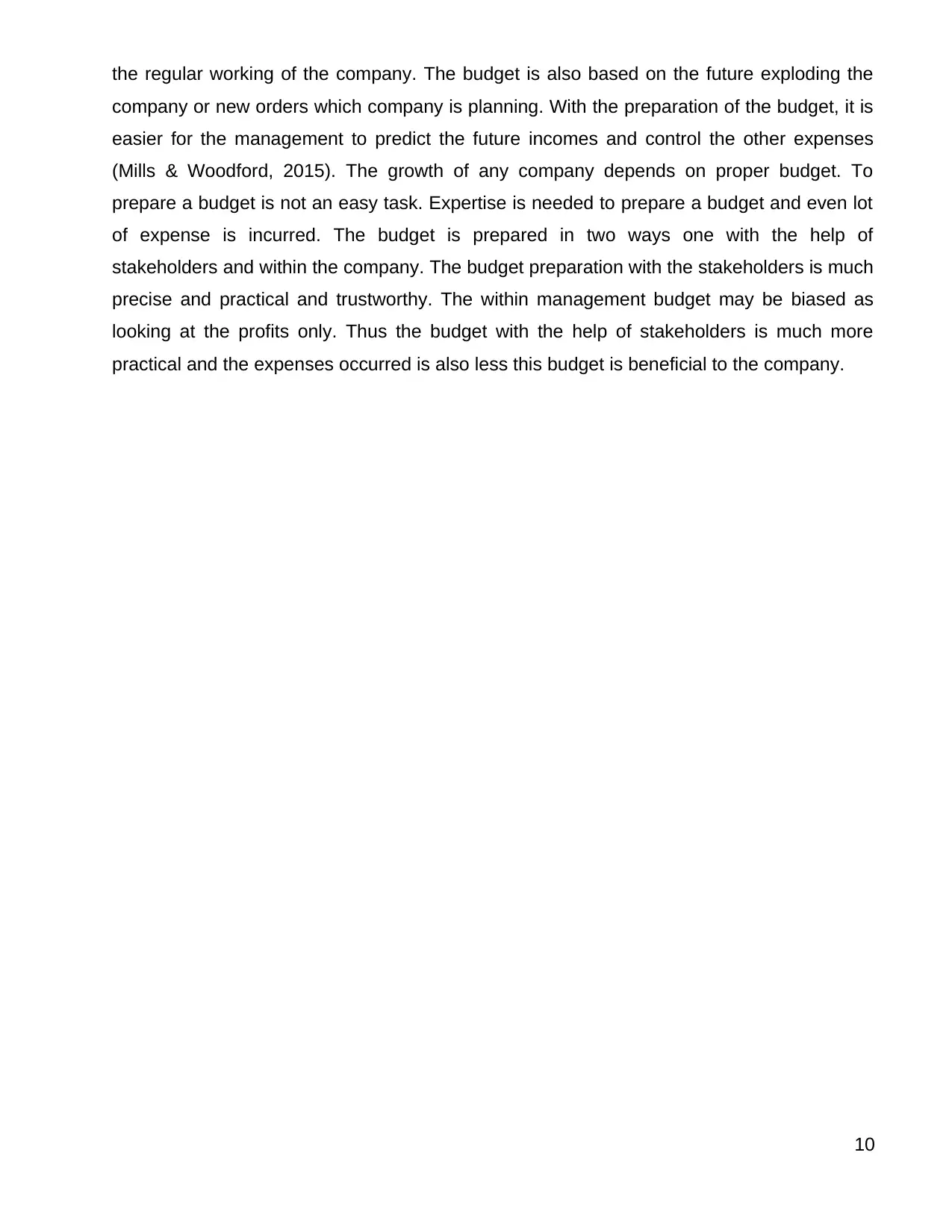
the regular working of the company. The budget is also based on the future exploding the
company or new orders which company is planning. With the preparation of the budget, it is
easier for the management to predict the future incomes and control the other expenses
(Mills & Woodford, 2015). The growth of any company depends on proper budget. To
prepare a budget is not an easy task. Expertise is needed to prepare a budget and even lot
of expense is incurred. The budget is prepared in two ways one with the help of
stakeholders and within the company. The budget preparation with the stakeholders is much
precise and practical and trustworthy. The within management budget may be biased as
looking at the profits only. Thus the budget with the help of stakeholders is much more
practical and the expenses occurred is also less this budget is beneficial to the company.
10
company or new orders which company is planning. With the preparation of the budget, it is
easier for the management to predict the future incomes and control the other expenses
(Mills & Woodford, 2015). The growth of any company depends on proper budget. To
prepare a budget is not an easy task. Expertise is needed to prepare a budget and even lot
of expense is incurred. The budget is prepared in two ways one with the help of
stakeholders and within the company. The budget preparation with the stakeholders is much
precise and practical and trustworthy. The within management budget may be biased as
looking at the profits only. Thus the budget with the help of stakeholders is much more
practical and the expenses occurred is also less this budget is beneficial to the company.
10
Paraphrase This Document
Need a fresh take? Get an instant paraphrase of this document with our AI Paraphraser
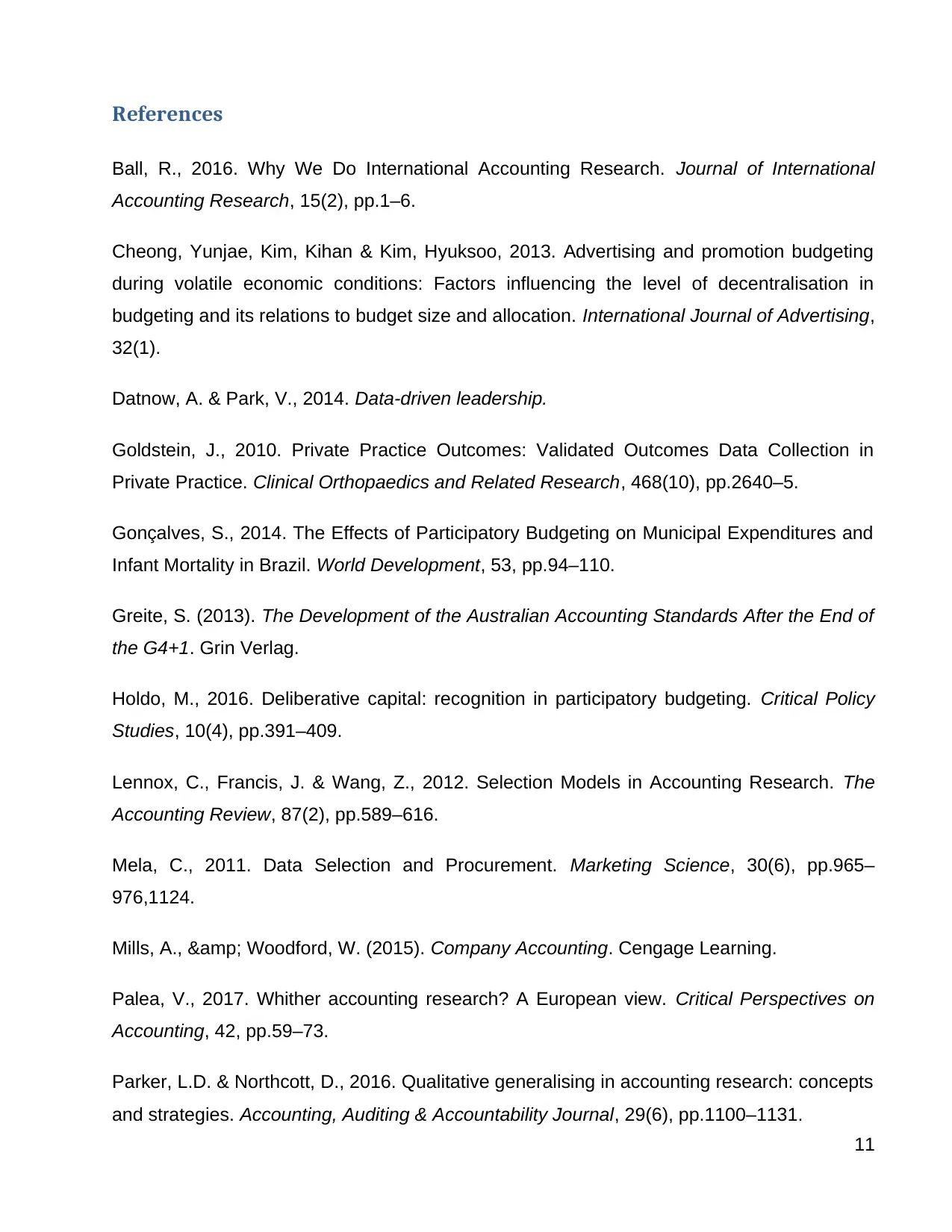
References
Ball, R., 2016. Why We Do International Accounting Research. Journal of International
Accounting Research, 15(2), pp.1–6.
Cheong, Yunjae, Kim, Kihan & Kim, Hyuksoo, 2013. Advertising and promotion budgeting
during volatile economic conditions: Factors influencing the level of decentralisation in
budgeting and its relations to budget size and allocation. International Journal of Advertising,
32(1).
Datnow, A. & Park, V., 2014. Data-driven leadership.
Goldstein, J., 2010. Private Practice Outcomes: Validated Outcomes Data Collection in
Private Practice. Clinical Orthopaedics and Related Research, 468(10), pp.2640–5.
Gonçalves, S., 2014. The Effects of Participatory Budgeting on Municipal Expenditures and
Infant Mortality in Brazil. World Development, 53, pp.94–110.
Greite, S. (2013). The Development of the Australian Accounting Standards After the End of
the G4+1. Grin Verlag.
Holdo, M., 2016. Deliberative capital: recognition in participatory budgeting. Critical Policy
Studies, 10(4), pp.391–409.
Lennox, C., Francis, J. & Wang, Z., 2012. Selection Models in Accounting Research. The
Accounting Review, 87(2), pp.589–616.
Mela, C., 2011. Data Selection and Procurement. Marketing Science, 30(6), pp.965–
976,1124.
Mills, A., & Woodford, W. (2015). Company Accounting. Cengage Learning.
Palea, V., 2017. Whither accounting research? A European view. Critical Perspectives on
Accounting, 42, pp.59–73.
Parker, L.D. & Northcott, D., 2016. Qualitative generalising in accounting research: concepts
and strategies. Accounting, Auditing & Accountability Journal, 29(6), pp.1100–1131.
11
Ball, R., 2016. Why We Do International Accounting Research. Journal of International
Accounting Research, 15(2), pp.1–6.
Cheong, Yunjae, Kim, Kihan & Kim, Hyuksoo, 2013. Advertising and promotion budgeting
during volatile economic conditions: Factors influencing the level of decentralisation in
budgeting and its relations to budget size and allocation. International Journal of Advertising,
32(1).
Datnow, A. & Park, V., 2014. Data-driven leadership.
Goldstein, J., 2010. Private Practice Outcomes: Validated Outcomes Data Collection in
Private Practice. Clinical Orthopaedics and Related Research, 468(10), pp.2640–5.
Gonçalves, S., 2014. The Effects of Participatory Budgeting on Municipal Expenditures and
Infant Mortality in Brazil. World Development, 53, pp.94–110.
Greite, S. (2013). The Development of the Australian Accounting Standards After the End of
the G4+1. Grin Verlag.
Holdo, M., 2016. Deliberative capital: recognition in participatory budgeting. Critical Policy
Studies, 10(4), pp.391–409.
Lennox, C., Francis, J. & Wang, Z., 2012. Selection Models in Accounting Research. The
Accounting Review, 87(2), pp.589–616.
Mela, C., 2011. Data Selection and Procurement. Marketing Science, 30(6), pp.965–
976,1124.
Mills, A., & Woodford, W. (2015). Company Accounting. Cengage Learning.
Palea, V., 2017. Whither accounting research? A European view. Critical Perspectives on
Accounting, 42, pp.59–73.
Parker, L.D. & Northcott, D., 2016. Qualitative generalising in accounting research: concepts
and strategies. Accounting, Auditing & Accountability Journal, 29(6), pp.1100–1131.
11
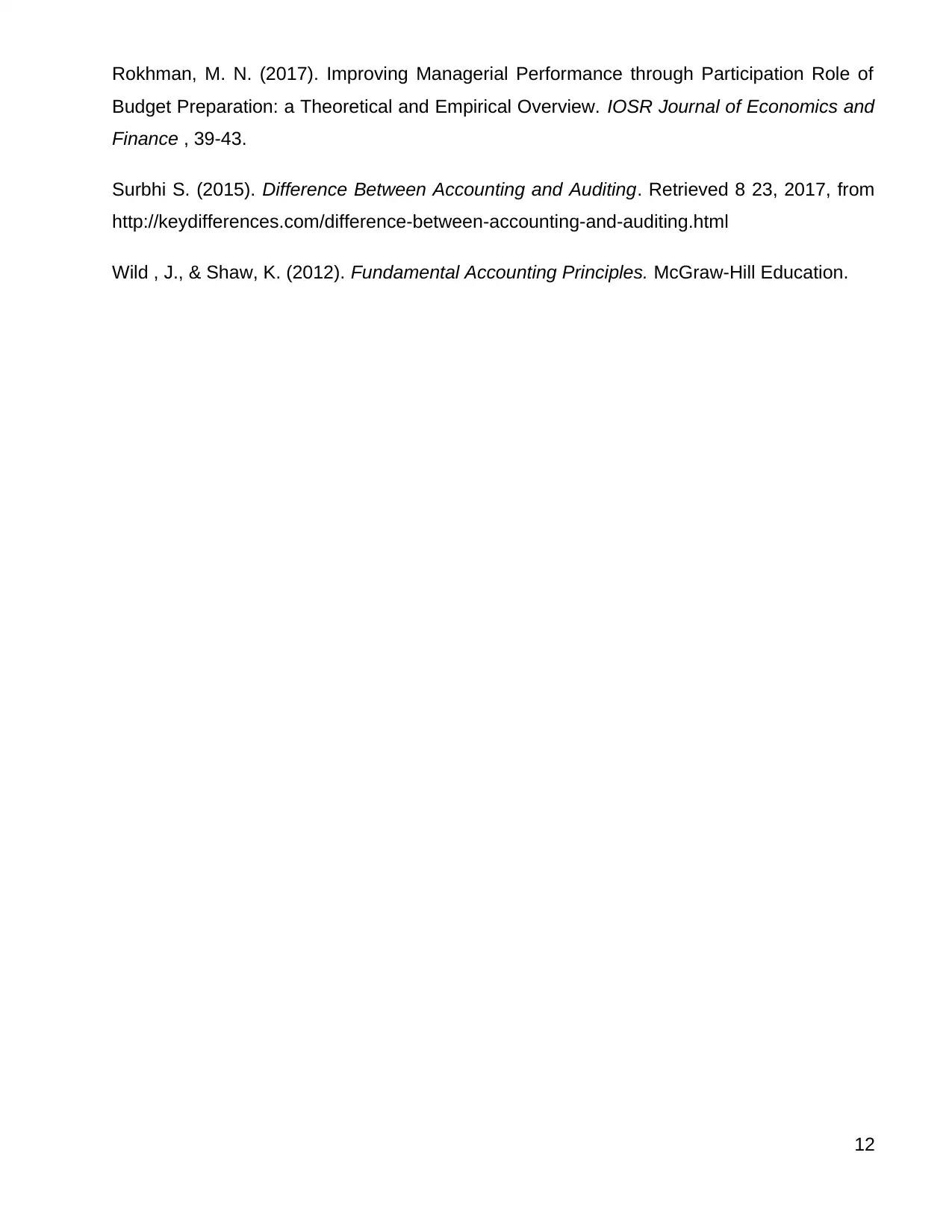
Rokhman, M. N. (2017). Improving Managerial Performance through Participation Role of
Budget Preparation: a Theoretical and Empirical Overview. IOSR Journal of Economics and
Finance , 39-43.
Surbhi S. (2015). Difference Between Accounting and Auditing. Retrieved 8 23, 2017, from
http://keydifferences.com/difference-between-accounting-and-auditing.html
Wild , J., & Shaw, K. (2012). Fundamental Accounting Principles. McGraw-Hill Education.
12
Budget Preparation: a Theoretical and Empirical Overview. IOSR Journal of Economics and
Finance , 39-43.
Surbhi S. (2015). Difference Between Accounting and Auditing. Retrieved 8 23, 2017, from
http://keydifferences.com/difference-between-accounting-and-auditing.html
Wild , J., & Shaw, K. (2012). Fundamental Accounting Principles. McGraw-Hill Education.
12
⊘ This is a preview!⊘
Do you want full access?
Subscribe today to unlock all pages.

Trusted by 1+ million students worldwide
1 out of 12
Related Documents
Your All-in-One AI-Powered Toolkit for Academic Success.
+13062052269
info@desklib.com
Available 24*7 on WhatsApp / Email
![[object Object]](/_next/static/media/star-bottom.7253800d.svg)
Unlock your academic potential
Copyright © 2020–2025 A2Z Services. All Rights Reserved. Developed and managed by ZUCOL.





